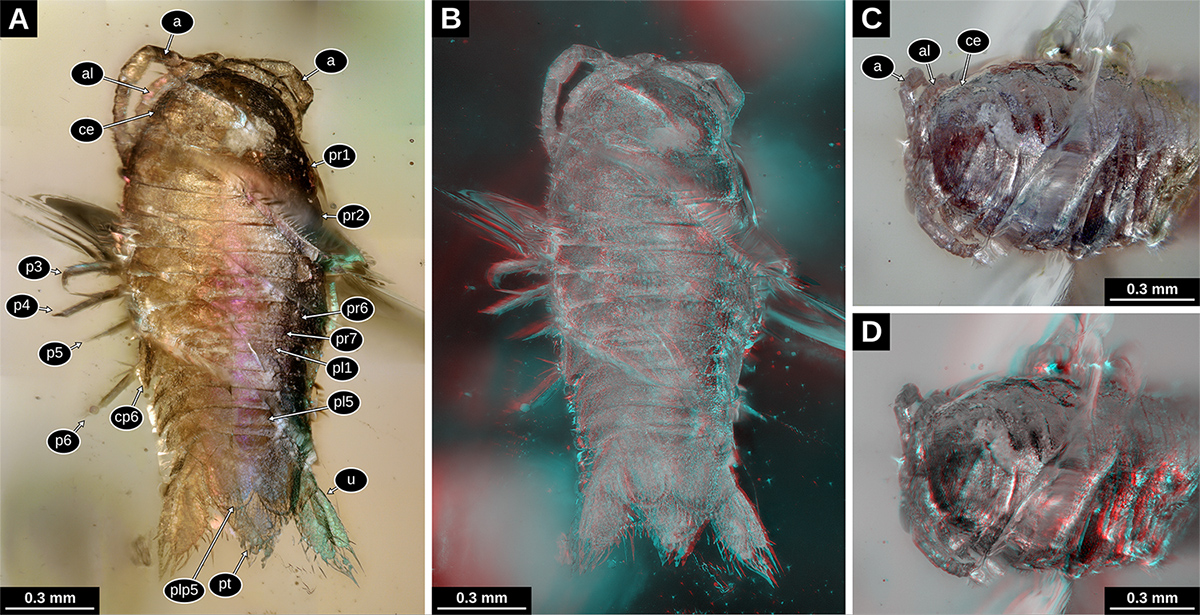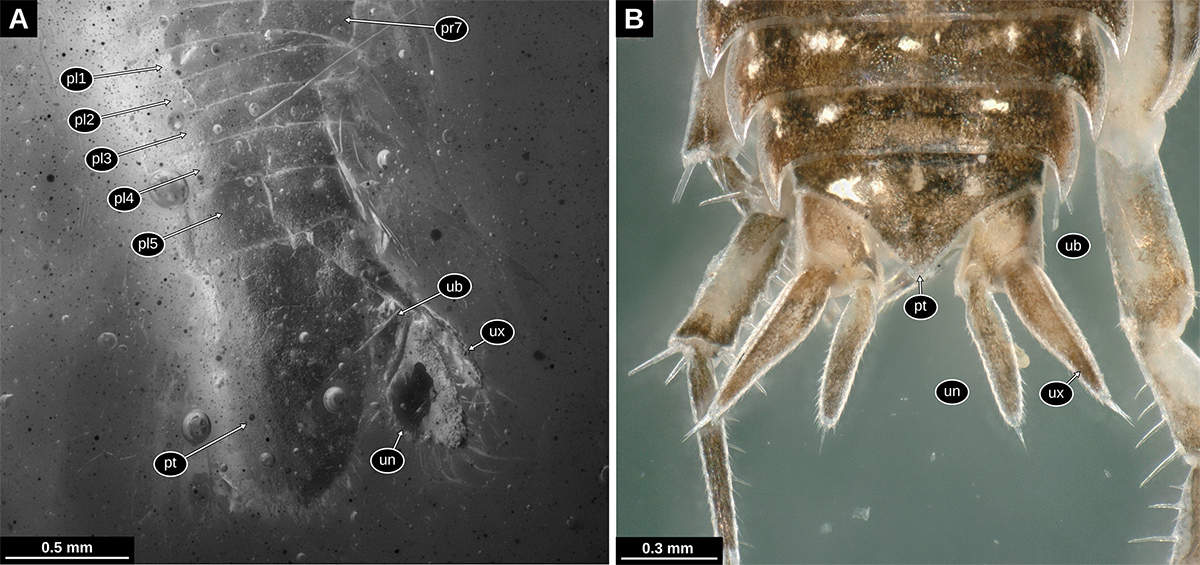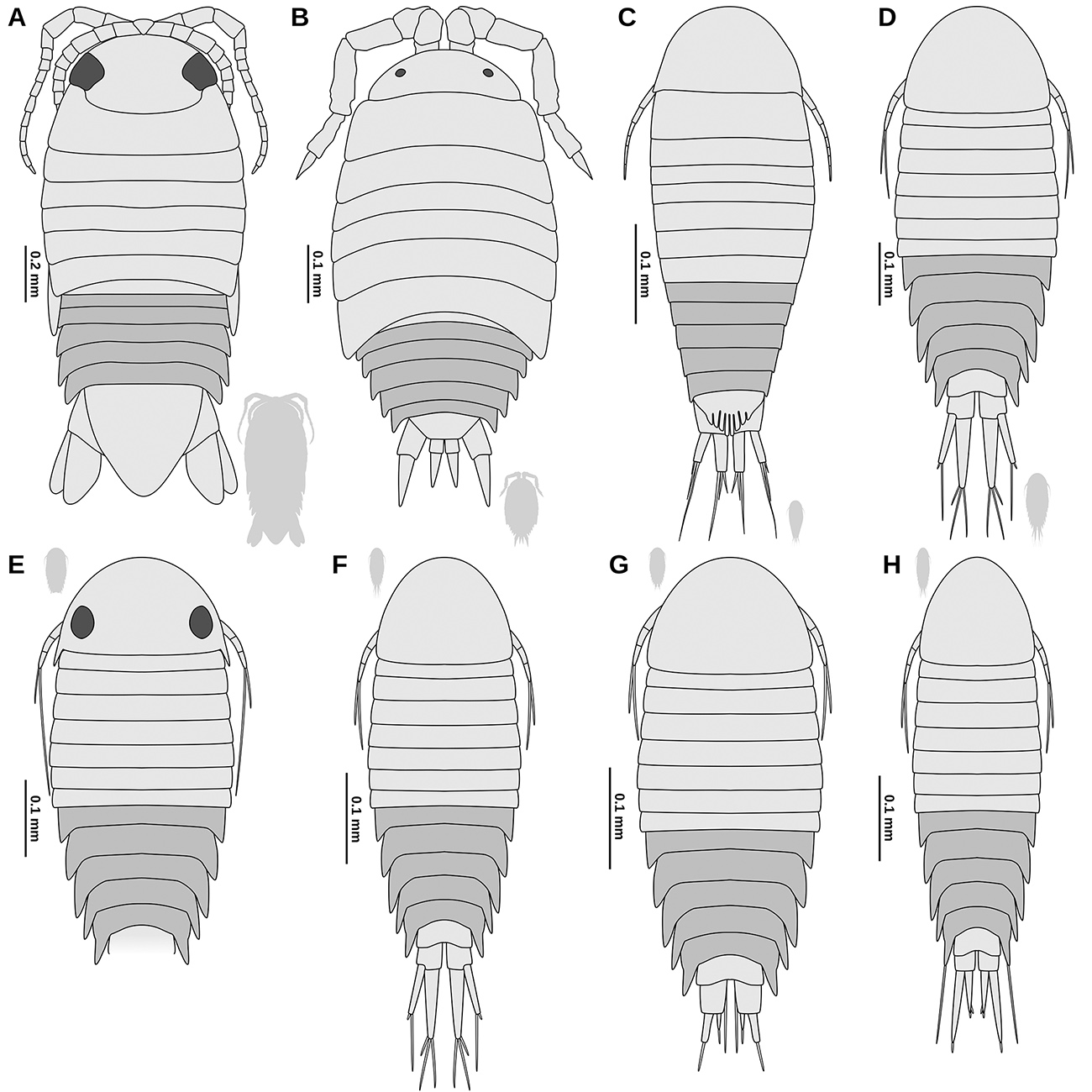Figure 1.
A: Map of Myanmar, white star marks the location of the Burmese amber mining sites near the town Noje Bum, base map from OpenStreetMap (openstreetmap.org); B: palaeogeographic world map, Aitov projection, 100 million years in the past, base image from PALEOMAP project (
Scotese, 2016Scotese, C.R. 2016. PALEOMAP PaleoAtlas for GPlates and the PaleoData Plotter Program, PALEOMAP Project, PALEOMAP PaleoAtlas for GPlates and the PaleoData Plotter Program, PALEOMAP Project, http://www.earthbyte.org/paleomap-paleoatlas-for-gplates/ . Accessed on 11 June 2020.
http://www.earthbyte.org/paleomap-paleoa...
), red star marks the location of the Burmese amber sites.
Figure 2.
Paratype of Electrolana madelineae sp. nov. (NHMW 2017/0052/0002). A: Habitus in dorsal view, white light microscopy, coaxial light and polarising filter, 300x (VHX); B: habitus in dorsal view, red-cyan stereo anaglyph, white light microscopy, 200x (VHX); C: head region in antero-dorsal view, white light microscopy, 200x (VHX); D: head region in antero-dorsal view, red-cyan stereo anaglyph, white light microscopy, 200x (VHX). a, antenna; al, antennula; ce, compound eye; cp6, coxal plate of trunk segment 6; p3-6, trunk appendages 3-6; pl, pleon segments 1-5; plp5, pleopod 5; pr1-7, trunk segments 1-7; pt, pleotelson; u, uropod.
Figure 3.
Paratype of Electrolana madelineae sp. nov. (NHMW 2017/0052/0002). A: Habitus in ventral view, white light microscopy, 300x (VHX); B: habitus in ventral view, red-cyan stereo anaglyph, white light microscopy, 200x; C: habitus in ventral view, epifluorescence microscopy, 4x (BZ); D: distal region of trunk appendages 1 and 2 in ventral view, right body side, white light microscopy, 300x (VHX); E: head in ventral view, white light microscopy, desaturated with colour markings, red mandible, blue maxillula, yellow maxilla, green maxilliped, 300x (VHX); F: pleon region in ventral view, white light microscopy, 300x (VHX); G: pleon region in ventral view, white light microscopy, desaturated and inverted, with color markings, yellow basipod, green endopod, blue exopod, 300x (VHX). a, antenna; al, antennula; cl, clypeus; dc, dorsal claw; ed, endite of the maxilliped; fl, frontal lamina; lb, labrum; mp, mandibular palp; mxp, maxilliped; p1-6, trunk appendages 1-6; plp1-5, pleopod 1-5; pt, pleotelson; sr, serration pattern; u, uropod.
Figure 4.
Holotype of Electrolana madelineae sp. nov. (NHMW 2017/0052/0001). A: Habitus in dorsal view, white light microscopy, 200x (VHX). B: anterior head region in ventro-lateral view, transmitted light microscopy, 4x (BZ); C: anterior body region in ventro-lateral view, white light microscopy, 200x (VHX); D: anterior trunk region in ventro-lateral view, white light microscopy, 150x (VHX); E: head region in dorsal view, left body side, white light microscopy, 200x (VHX). a, antenna; al, antennula; ce, compound eye; cp6-7, coxal plate of trunk segment 6-7;mp, mandibular palp; o, seed shrimp (Ostracoda); p1-7, trunk appendages 1-7; pt, pleotelson; ub, uropod basipod; un, uropod endopod; ux, uropod exopod.
Figure 5.
Holotype of Electrolana madelineae sp. nov. (NHMW 2017/0052/0001), volume rendering images based on micro-CT data. A: Habitus in dorsal view, orthographic projection; B: habitus in ventral view, orthographic projection; C: habitus in ventral view, red-cyan stereo anaglyph, perspective projection; D: habitus in lateral view, right body side, red-cyan stereo anaglyph, perspective projection. a, antenna; al, antennula; cp7, coxal plate of trunk segment 7; p1-6, trunk appendages 1-6; pt, pleotelson; un, uropod endopod; ux, uropod exopod; ?, unknown material forming an irregular bubble.
Figure 6.
Drawing of the holotype of Electrolana madelineae sp. nov. (NHMW 2017/0052/0001), dorsal view, composite of microscopic images and micro-CT scan data.
Figure 7.
Comparison of the uropod morphology between Electrolana madelineae sp. nov. and an extant representative of Oniscidea. A: Holotype of Electrolana madelineae sp. nov. (NHMW 2017/0052/0001), pleon region in latero-dorsal view, epifluorescence microscopy, 4x (BZ); B: Philoscia cf. muscorum (Scopoli, 1763), posterior pleon region in dorsal view, white light microscopy, 200x (VHX). pl, pleon segments 1-5; pr7, trunk segment 7; pt, pleotelson; ub, uropod basipod; un, uropod endopod; ux, uropod exopod.
Figure 8.
Comparison of the distal part of trunk appendage 1 in different lineages of Cymothoida. A: Electrolana madelineae n. sp., schematic reconstruction; B: Cirolana australiense Hale, 1925, redrawn from Bruce (1986, fig. 114LBruce, N.L. 1986. Cirolanidae (Crustacea: Isopoda) of Australia. Records of the Australian Museum, Supplement, 6: 1-239.); C: Elthusa vulgaris (Stimpson, 1857), drawn after van der Wal and Haug (2020, fig. 16Bvan der Wal, S. and Haug, J.T. 2020. Shape of attachment structures in parasitic isopodan crustaceans: the influence of attachment site and ontogeny. PeerJ, 8: e9181.). d, dactylus, dc, claws of dactylus, pp, propodus.
Figure 9.
Holotype of Electrolana madelineae sp. nov. (NHMW 2017/0052/0001), habitus in ventrolateral view and surrounding objects in the resin, volume rendering image, two different transfer functions and clipping planes applied, orange colour transfer function solely depicts extremely low-x-ray contrast areas (gas phase). ab, air bubble; l, leg, Euarthropoda.
Figure 10.
Graphical summary of all known manca-stage or larval fossils of Isopoda, reconstruction line drawings, free pleon tergites (postocular segments 14-18) in darker grey. A. Paratype of Electrolana madelineae sp. nov. (NHMW 2017/0052/0002); B: Aquitanoscia chiapasensisBroly et al., 2017Broly, P.; Serrano-Sánchez, M. de L.; Rodríguez-García, S. and Vega, F.J. 2017. Fossil evidence of extended brood care in new Miocene Peracarida (Crustacea) from Mexico. Journal of Systematic Palaeontology, 15: 1037-1049.; C: Vacuotheca dupeorumSchädel et al., 2019bSchädel, M.; Perrichot, V. and Haug, J. 2019b. Exceptionally preserved cryptoniscium larvae - morphological details of rare isopod crustaceans from French Cretaceous Vendean amber. Palaeontologia Electronica, 22.3.71: 1-46.; D: IHNFG-4951-Ep1 (‘specimen 2’) Serrano Sanchez et al. (2016)Serrano-Sánchez, M. de L.; Nagler, C.; Haug, C.; Haug, J.T.; Centeno-García, E. and Vega, F.J. 2016. The first fossil record of larval stages of parasitic isopods: cryptoniscus larvae preserved in Miocene amber. Neues Jahrbuch für Geologie und Paläontologie-Abhandlungen, 279: 97-106.; E: openstreetmap.org IHNFG-4964-Ep2 (‘specimen 5b’) Serrano Sanchez et al. (2016)Serrano-Sánchez, M. de L.; Nagler, C.; Haug, C.; Haug, J.T.; Centeno-García, E. and Vega, F.J. 2016. The first fossil record of larval stages of parasitic isopods: cryptoniscus larvae preserved in Miocene amber. Neues Jahrbuch für Geologie und Paläontologie-Abhandlungen, 279: 97-106.; F: IHNFG-5321-Ep1 (‘specimen 6’) Serrano Sanchez et al. (2016)Serrano-Sánchez, M. de L.; Nagler, C.; Haug, C.; Haug, J.T.; Centeno-García, E. and Vega, F.J. 2016. The first fossil record of larval stages of parasitic isopods: cryptoniscus larvae preserved in Miocene amber. Neues Jahrbuch für Geologie und Paläontologie-Abhandlungen, 279: 97-106.; G: IHNFG-4971-Ep1 (‘specimen 3’) Serrano Sanchez et al. (2016)Serrano-Sánchez, M. de L.; Nagler, C.; Haug, C.; Haug, J.T.; Centeno-García, E. and Vega, F.J. 2016. The first fossil record of larval stages of parasitic isopods: cryptoniscus larvae preserved in Miocene amber. Neues Jahrbuch für Geologie und Paläontologie-Abhandlungen, 279: 97-106.; H: IHNFG-4939-Ep1 (‘specimen 1’) Serrano Sanchez et al. (2016)Serrano-Sánchez, M. de L.; Nagler, C.; Haug, C.; Haug, J.T.; Centeno-García, E. and Vega, F.J. 2016. The first fossil record of larval stages of parasitic isopods: cryptoniscus larvae preserved in Miocene amber. Neues Jahrbuch für Geologie und Paläontologie-Abhandlungen, 279: 97-106..

 Thumbnail
Thumbnail
 Thumbnail
Thumbnail
 Thumbnail
Thumbnail
 Thumbnail
Thumbnail
 Thumbnail
Thumbnail
 Thumbnail
Thumbnail
 Thumbnail
Thumbnail
 Thumbnail
Thumbnail
 Thumbnail
Thumbnail
 Thumbnail
Thumbnail









